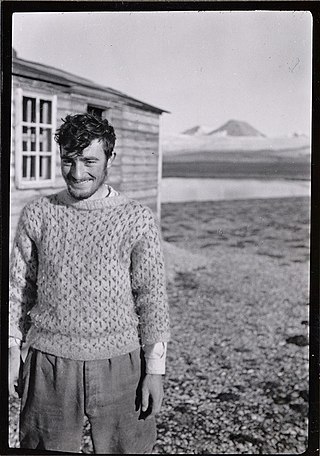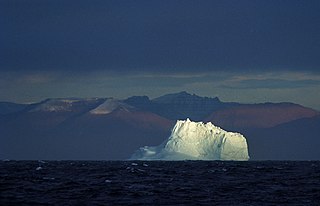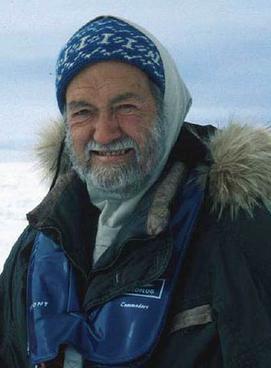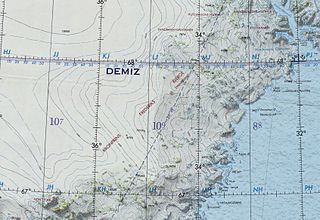Related Research Articles

Spitsbergen is the largest and the only permanently populated island of the Svalbard archipelago in northern Norway.

Nils Adolf Erik Nordenskiöld was a Finland-Swedish aristocrat, geologist, mineralogist and Arctic explorer. He was a member of the Fenno-Swedish Nordenskiöld family of scientists and held the title of a friherre (baron). His ethnicity was Finnish-Swedish.

Fram ("Forward") is a ship that was used in expeditions of the Arctic and Antarctic regions by the Norwegian explorers Fridtjof Nansen, Otto Sverdrup, Oscar Wisting, and Roald Amundsen between 1893 and 1912. It was designed and built by the Scottish-Norwegian shipwright Colin Archer for Fridtjof Nansen's 1893 Arctic expedition in which the plan was to freeze Fram into the Arctic ice sheet and float with it over the North Pole.

Alfred Gabriel Nathorst was a Swedish Arctic explorer, geologist, and palaeobotanist.

Walter Brian Harland was a British geologist at the Department of Geology, later University of Cambridge Department of Earth Sciences, England, from 1948 to 2003. He was a leading figure in geological exploration and research in Svalbard, organising over 40 Cambridge Spitsbergen Expeditions (CSE) and in 1975 founded the Cambridge Arctic Shelf Programme (CASP) as a research institute to continue this work. He was first secretary of the International Geological Correlation Programme from 1969 until UNESCO could take over in 1972, and was a driving force in setting criteria and standards in stratigraphy and producing 4 editions of the geological time scale in 1964, 1971, 1982 and 1989. He also edited the international Geological Magazine for 30 years. In 1968, he was honoured with the Royal Geographical Society Gold Medal for Arctic exploration and research.

The Norwegian Polar Institute is Norway's central governmental institution for scientific research, mapping and environmental monitoring in the Arctic and the Antarctic. The NPI is a directorate under Norway's Ministry of Climate and Environment. The institute advises Norwegian authorities on matters concerning polar environmental management and is the official environmental management body for Norwegian activities in Antarctica.

Edgeøya, anglicised as Edge Island, is a Norwegian island located in southeast of the Svalbard archipelago; with an area of 5,073 square kilometres (1,960 sq mi), it is the third-largest island in this archipelago. An Arctic island, it forms part of the Søraust-Svalbard Nature Reserve, home to polar bears and reindeer. An ice field covers its eastern side. The island takes its name from Thomas Edge, an English merchant and whaler. It is seldom visited today and development of tourist facilities is forbidden by law because of its nature reserve status.

The Greenland Sea is a body of water that borders Greenland to the west, the Svalbard archipelago to the east, Fram Strait and the Arctic Ocean to the north, and the Norwegian Sea and Iceland to the south. The Greenland Sea is often defined as part of the Arctic Ocean, sometimes as part of the Atlantic Ocean. However, definitions of the Arctic Ocean and its seas tend to be imprecise or arbitrary. In general usage the term "Arctic Ocean" would exclude the Greenland Sea. In oceanographic studies the Greenland Sea is considered part of the Nordic Seas, along with the Norwegian Sea. The Nordic Seas are the main connection between the Arctic and Atlantic oceans and, as such, could be of great significance in a possible shutdown of thermohaline circulation. In oceanography the Arctic Ocean and Nordic Seas are often referred to collectively as the "Arctic Mediterranean Sea", a marginal sea of the Atlantic.

Sir Walter William Herbert was a British polar explorer, writer and artist. In 1969 he became the first man fully recognized for walking to the North Pole, on the 60th anniversary of Robert Peary's disputed expedition. He was described by Sir Ranulph Fiennes as "the greatest polar explorer of our time".
Teodor Gheorghe Negoiță was a polar region explorer. In 1995 he became the first known Romanian explorer to reach the North Pole.
Eric Philips OAM is an Australian polar explorer, adventurer and polar guide.

The Fram Strait is the passage between Greenland and Svalbard, located roughly between 77°N and 81°N latitudes and centered on the prime meridian. The Greenland and Norwegian Seas lie south of Fram Strait, while the Nansen Basin of the Arctic Ocean lies to the north. Fram Strait is noted for being the only deep connection between the Arctic Ocean and the World Oceans. The dominant oceanographic features of the region are the West Spitsbergen Current on the east side of the strait and the East Greenland Current on the west.

Gunnerius Ingvald Isachsen, was a Norwegian military officer and polar scientist. From 1923, he was the first president of the Norwegian Maritime Museum.

Alexander Piers William Hibbert is a British polar expedition leader, public speaker, author and photographer. He lives in London.

Paul-Louis Mercanton was a Swiss glaciologist, meteorologist and Arctic explorer.

Alain Hubert is a Belgian explorer. He is a certified mountain and polar guide, a civil engineer, and the founder President of the International Polar Foundation. With the Foundation and its private partners, he built and financed the construction of the scientific research station ‘Princess Elisabeth’. This station is the first ‘Zero Emissions’ station in Antarctica, designed under the spirit of the Madrid protocol system establishing in 1992 the strictest environmental rules to date for a continent through the Antarctic Treaty System.
John Huston is an American polar explorer, motivational speaker, wilderness guide, and safety and logistics consultant. In 2009, Huston completed the first successful unsupported American expedition to the North Pole. He has also completed expeditions to the South Pole, Greenland, and Ellesmere Island. Huston is the co-author of Forward: The First American Unsupported Expedition to the North Pole.

Schweizerland, also known as Schweizerland Alps, is a mountain range in King Christian IX Land, eastern Greenland. Administratively this range is part of the Sermersooq Municipality. Its highest point is one of the highest peaks in Greenland.

The Crown Prince Frederick Range is a large mountain range in King Christian IX Land, eastern Greenland. Administratively this range is part of the Sermersooq Municipality.
References
- ↑ Tangent Expedition Reports Archived 2016-06-24 at the Wayback Machine
- ↑ Robinson-Tate, Michaela (30 March 2001). "Local man leads Arctic expedition". The Westmoreland Gazette. Retrieved 29 November 2022.
- Growing old disgracefully in Greenland
- https://web.archive.org/web/20120327213914/http://www.nicearticles.net/travel-and-leisure/198-outdoors/3466-greenland-and-arctic-mountaineering-expeditions.html
- Greenland: Paul Stern Land first ascents.
- http://www.karabiner.org/expeditions/1994-greenland/index.php
- https://web.archive.org/web/20120327213915/http://de.sky-cz.com/pilotenecke/roof-of-the-arctic-expedition/
- 1993 Alpine Journal. Article page 136 plus photos, plates 59-62.
- 1995 Alpine Journal. Article page 183 plus photos, plates 72-73.
- 1997 Alpine Journal. Article page 39 plus photos, plates 22-25.
- 1998 Alpine Journal. Article page 97 plus photos, plates 34-37. Further info. p. 231-236.
- 2000 Alpine Journal. Article page 80 plus photos, plates 26-28.
- 97 American Alpine Journal. Article page 222 plus photos p. 223-224.
- 98 American Alpine Journal.
- 99 Eagle Ski Club Year Book. Article p. 40 plus photos p. 46-47.
- 01 Eagle Ski Club Year Book. Article p. 78.
- Cumbria Life magazine January 2010 Issue 135 pages 58–63